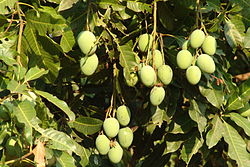Mango: Difference between revisions
No edit summary |
|||
| Line 27: | Line 27: | ||
== References == | == References == | ||
{{reflist}} | {{reflist}} | ||
{{Symbols of Bangladesh}} | {{Symbols of Bangladesh}} | ||
| Line 37: | Line 36: | ||
[[Category:Sapindales]] | [[Category:Sapindales]] | ||
[[Category:National symbols of Pakistan]] | [[Category:National symbols of Pakistan]] | ||
[[Category:State symbols of Junagadh (Pakistan)]] | |||
[[Category:National symbols of India]] | [[Category:National symbols of India]] | ||
[[Category:Former provincial symbols of East Bengal (Pakistan)]] | |||
Revision as of 18:59, 11 August 2022
| Mangifera indica | |
|---|---|

| |
| Unripe mango fruits | |
| Scientific classification | |
| Kingdom: | |
| Phylum: | |
| Class: | |
| Order: | |
| Family: | |
| Genus: | Mangifera |
A mango is a type of fruit. The mango tree is native to South Asia, from where it has been taken to become one of the most widely cultivated fruits in the tropics. It is harvested in the month of March (summer season) until the end of May.
Pakistan and India share the major export market of mangoes. It is also their national fruit. Ripe mangoes are very sweet in taste but they are bitterly sour before they ripen. There are many different types of mangoes found in India such as Langra, Dusshera, Chausa, Tota, Safadi. Alphonso mangoes can be found in various parts of western India. Mangoes may be used to make juices, mango nectar, and as a flavouring and major ingredient in mango ice cream and Sorbetes. The seed kernels can be roasted and eaten.[1]
These mangoes are also indigenous to the southern part of Nigeria, Akwa Ibom. Described by these southerners (the Ibibios) as Grade 1 mangoes.
Mango trees
The tree is mainly known for its fruit rather than for its wood. However, mango trees can be converted to lumber once their fruit bearing lifespan had finished. The wood is susceptible to damage from fungi and insects.[2] The wood is used for musical instruments such as Ukeleles,[2] plywood and low-cost furniture.[3] The wood is also known to produce phenolic substances that can cause dermatitis.[4] It was the state tree of Junagadh State.
References
- ↑ Cite error: Invalid
<ref>tag; no text was provided for refs named:0 - ↑ 2.0 2.1 "Mango". The Wood Database. Retrieved 30 August 2014.
- ↑ "Economic importance of Mangifera indica". Green Clean Guide. Archived from the original on 7 February 2015. Retrieved 30 August 2014.
- ↑ Tu, series editor, Anthony T. (1983). Handbook of natural toxins. New York: Dekker. p. 425. ISBN 0824718933.
{{cite book}}:|access-date=requires|url=(help);|first1=has generic name (help)CS1 maint: multiple names: authors list (link)
